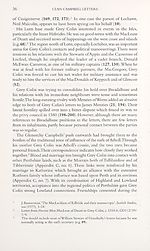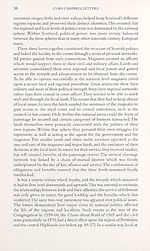Series 5 > Campbell Letters 1559-1583
(56) Page 37
Download files
Complete book:
Individual page:
Thumbnail gallery: Grid view | List view

INTRODUCTION
37
Reformation crisis proved important in widening his links with figures
of national importance. Lord James Stewart, earl of Moray, James Douglas,
fourth earl of Morton, and even James Hamilton, duke of Chatelherault,
were warm correspondents (1, 2, 16, 45-6, 50, 76, 157).The personal
friendship between Katherine andWilham Maitland of Lethington, the
queen’s secretary, is striking (see above, p. 28). At a lower social level,
many court officials such as John MacGill of Nether Rankeillour, clerk
register (15), John Fenton, comptroller clerk (202), and John Wood,
Moray’s secretary (40), were all willing to provide information or assistance
to Katherine or Grey Cohn.
The written link with the royal court was particularly vital for Grey
Cohn. Unusually for an ambitious laird, Glenorchy was a reluctant traveller
to Edinburgh. He relied instead upon the visits to court of his wife, for
example in 1565 (see below, p. 52), or his older sons, Black Duncan and
Colin ofArdbeich (e.g. 199, 201). He was also dependent upon the news
and help he received from his clan chief and from his relations, particularly
Atholl and the third and fourth Lords Ruthven, as well as other friends.
Without such assistance at the centre, Grey Colin’s local influence would
have been severely diminished. By means of his numerous powerful
contacts, Grey Cohn was usuahy able to keep the court on his side during
the feud with the MacGregors which permitted him to utilise royal
authority against them (see below, pp. 57-60).
The structure of politics
The Breadalbane letters lay bare a vertical section through the three
layers of the kingdom’s pohtics, national, regional and local revealing
how the political mechanisms functioned between the interlocking levels.
The variety of correspondents in the Breadalbane cohection, ranging
from magnates to lesser lairds and servitors, illuminate the different
perspectives to be found within each of these layers.
Sixteenth-century Scotland comprised an aggregate of small enclosed
communities rather than a single unified state. Although the kingdom
possessed central pohtical, administrative, financial and judicial institutions,
their authority was limited and did not stretch evenly across the realm.
The church was the only institution with a fully comprehensive national
organisation.The crown relied primarily upon its own personal authority
and utilised the Scottish magnates to implement its policies. Until the
changes brought by the reforms of James Vi’s personal reign, political
power remained decentralised, being retained at local, as well as regional,
levels. Poor communications and substantial natural barriers, such as
37
Reformation crisis proved important in widening his links with figures
of national importance. Lord James Stewart, earl of Moray, James Douglas,
fourth earl of Morton, and even James Hamilton, duke of Chatelherault,
were warm correspondents (1, 2, 16, 45-6, 50, 76, 157).The personal
friendship between Katherine andWilham Maitland of Lethington, the
queen’s secretary, is striking (see above, p. 28). At a lower social level,
many court officials such as John MacGill of Nether Rankeillour, clerk
register (15), John Fenton, comptroller clerk (202), and John Wood,
Moray’s secretary (40), were all willing to provide information or assistance
to Katherine or Grey Cohn.
The written link with the royal court was particularly vital for Grey
Cohn. Unusually for an ambitious laird, Glenorchy was a reluctant traveller
to Edinburgh. He relied instead upon the visits to court of his wife, for
example in 1565 (see below, p. 52), or his older sons, Black Duncan and
Colin ofArdbeich (e.g. 199, 201). He was also dependent upon the news
and help he received from his clan chief and from his relations, particularly
Atholl and the third and fourth Lords Ruthven, as well as other friends.
Without such assistance at the centre, Grey Colin’s local influence would
have been severely diminished. By means of his numerous powerful
contacts, Grey Cohn was usuahy able to keep the court on his side during
the feud with the MacGregors which permitted him to utilise royal
authority against them (see below, pp. 57-60).
The structure of politics
The Breadalbane letters lay bare a vertical section through the three
layers of the kingdom’s pohtics, national, regional and local revealing
how the political mechanisms functioned between the interlocking levels.
The variety of correspondents in the Breadalbane cohection, ranging
from magnates to lesser lairds and servitors, illuminate the different
perspectives to be found within each of these layers.
Sixteenth-century Scotland comprised an aggregate of small enclosed
communities rather than a single unified state. Although the kingdom
possessed central pohtical, administrative, financial and judicial institutions,
their authority was limited and did not stretch evenly across the realm.
The church was the only institution with a fully comprehensive national
organisation.The crown relied primarily upon its own personal authority
and utilised the Scottish magnates to implement its policies. Until the
changes brought by the reforms of James Vi’s personal reign, political
power remained decentralised, being retained at local, as well as regional,
levels. Poor communications and substantial natural barriers, such as
Set display mode to:
![]() Universal Viewer |
Universal Viewer | ![]() Mirador |
Large image | Transcription
Mirador |
Large image | Transcription
Images and transcriptions on this page, including medium image downloads, may be used under the Creative Commons Attribution 4.0 International Licence unless otherwise stated. ![]()
| Scottish History Society volumes > Series 5 > Campbell Letters 1559-1583 > (56) Page 37 |
|---|
| Permanent URL | https://digital.nls.uk/128288464 |
|---|
| Description | Over 180 volumes, published by the Scottish History Society, containing original sources on Scotland's history and people. With a wide range of subjects, the books collectively cover all periods from the 12th to 20th centuries, and reflect changing trends in Scottish history. Sources are accompanied by scholarly interpretation, references and bibliographies. Volumes are usually published annually, and more digitised volumes will be added as they become available. |
|---|


